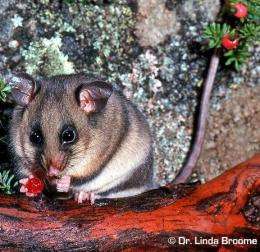Can the past secure pygmy possum's future?

Australia's ancient past may provide vital clues about how to secure the future of one of Australia's most endangered animals, the charismatic mountain pygmy possum, according to leading palaeontologist Professor Mike Archer.
Although the highly specialised tiny possum is today restricted to only a few high-altitude areas of the Australian Alps -where it hibernates in winter beneath the snow - the fossil record shows that for at least 26 million years its ancestors dwelt happily in lowland rainforests that had rocky floors, says Professor Archer, of the UNSW School of Biological, Earth and Environmental Sciences.
With global warming threatening to shrink its habitat even further, he has called on conservation authorities and fellow scientists to seriously consider his plan to test whether the possums could be successfully re-established in lowland forests similar to those where they formerly thrived.
Research by colleague Dr. Linda Broome, of the NSW Department of Environment, Climate Change and Water, has shown that only about 2,000 of the possums – Burramys parvus - remain in the wild and that their numbers are declining at an alarming rate.
Professor Archer says: "We can’t rely on just breeding them up for future release into alpine areas because climate change is already threatening that habitat. Yet we know that for at least the past 26 million years their ecological comfort zone was in much warmer wet lowland forests with rocky substrates. We don't know why they are so restricted now but they were clearly once much more widespread, so there's good reason to believe they could still survive and thrive at much lower altitudes. If so, we may be able to create new wild populations to ensure the survival of this lineage.
"The plan has two stages. It relies first on establishing a captive breeding colony that will also provide a safety net in case the remaining populations are hit by a major natural disaster, such as a failure of snow cover to provide sufficient insulation during the cold alpine winter. Breeding success would enable us to subsequently trial releasing some gradually acclimatised individuals, under carefully controlled conditions, into appropriate lowland forests.
"We already know from earlier breeding programs, such as those at Healesville Sanctuary in Victoria, that the possums do not need to hibernate – which seems to be a relatively recent adaptation to living above the snowline – and that they can thrive and reproduce at low altitudes and even enjoy a wider range of the increasingly scarce foods presently available to them in the alpine zone.
"Wherever we find them in the fossil record – as far afield as Central Australia, north-western Queensland and Western Victoria - they seem to have had little or no negative impact on other species, so we can be reasonably confident that we would not be creating problems in the ecosystems where they would be introduced. If anything, they seem to promote biodiversity."
Professor Archer's plan has already won support from the Foundation for National Parks and Wildlife and the Australian Geographic Society. The society's Conservationist of the Year, Trevor Evans, has pledged his support for the establishment of a breeding facility at the Secret Creek Sanctuary, near Lithgow, although legislative and funding hurdles remain to be negotiated.
Three UNSW research students are already working on aspects of this project. Hayley Bates is investigating why the possums are restricted to their present distribution; Alexis Meyer is studying their ecological role in past ecosystems; and Emma Hall is examining whether increasing stress is making some of them more vulnerable to parasites that may hasten their decline.
Provided by University of New South Wales
















